Resources by Carolyn M. Jones Medine
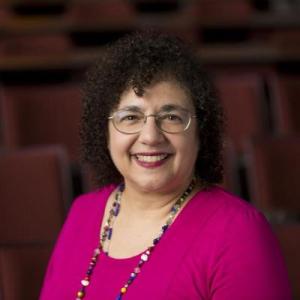
In October 2024, the Wabash Center hosted a “Curiosity Roundtable,” which I was honored to attend. The goal was to offer us experiences to help us; to encourage us to think outside the boxes that trap us as scholars, institutional citizens, and pedagogues. It was an amazing time, with voices that I am still thinking about, but, oddly, the experience that resounds, again and again, in my thoughts is the Porsche Experience.The group toured the Porsche Experience Center in Atlanta, GA. Those of us who did not get motion sickness—not me, dang it!—experienced driving the Porsche of our choice in the Simulator Lab. It was the tour, however, that had the impact on me. As the informed and enthusiastic guide showed us around, we were able to see, for example, the elements of making a Porsche. We saw a wall with the multiple tones of paint one could use on a Porsche body—some so subtly different that the guide said all buyers were urged to use a specialist in car design. We handled the key fobs and touched leathers used for interiors—just a few items among drawers of exquisite features. Then, we saw beautiful cars, on loan from collectors. What struck me was the flawlessness of these machines, but also, that they had very little mileage. These were cars that barely had been driven, mostly under 200 miles—they were tested, I thought, loaded for delivery, and put in a garage to gaze upon. Beautifully wrought, but, to me, kind of useless, except as possessions—though sort of like the excess of books in my library, I had to admit.It was the race cars, however, that made me see why the Wabash Center’s Executive Director, Dr. Lynne Westfield, brought us there. These cars tied the remarkable beauty of the collectable cars to function. One Porsche slogan is “Passion in Every Detail.” The Porsche desire includes “detailed craftsmanship, cutting edge innovation, and sheer passion.” That, I think, is what, we as devoted and innovative teacher-scholars practice and is what I saw in in the race cars. Those cars, like the Rothmans Porsche 962 on exhibit, were banged up, used over and over, and were examples of design reworked. These were the workhorses—like us professors—driven in 24 Hours of Le Mans, an endurance sports car race. I learned there why my daddy always bought Goodyear Tires. The Goodyears were so sturdy in the Le Mans that they had to be changed only once. These tires marked an adjustment, and what fascinated me were the adjustments: the redesigns. In the Rothmans we saw, the engine, first, was under the seat—not a great placement.As the guide talked about that, I said, “Someone died,” and he nodded.So, without losing speed or power, that one had to be adjusted.Beauty and function brought about through knowledge and innovation and carried out with passion—that is what kept running through my mind as we walked around. Every teacher in that group has been recognized, I know, as passionate about his or her subject matter and skilled: we are beauty in action. Beauty and function, carried out with passion, are the goals of great teaching. As teachers, I think we aim for the good, the true, and the beautiful. The classical Platonic understandings of those may not be same as they were for Plato, perhaps, but we seek to craft the vehicle that is so beautiful that it is utterly compelling—beauty draws and improves us, Plato argues--to our students that they will take the ride with us and risk encountering what we consider to be good and true. As Elaine Scarry reminds us in On Beauty and Being Just, a liberal arts education is the perpetuation of beauty. As human beings, we seek to copy the beautiful, and as we do so, we revise our own locations and beings. The beautiful, Scarry argues, helps “incite the will toward continual creation” (8). And, fairness, in terms of beauty, can lead to fairness, equality, in terms of justice: to being fair, to seeking “‘a symmetry of everyone’s relations to one another’” (95).The design of intellectual experience, as Patricia O’Connell Killen calls it, is the same as the design of those Porsche cars in another space. We go from finding and observing beauty to creating it ourselves in our syllabi and classrooms, to, as we teach, helping our students to see and create beauty themselves. Every piece in the collectable cars was a masterpiece of beauty—from the door handles to the key fobs. As a craftswoman teacher, I want my classes to be that way, beautifully constructed. The beauty embedded in the experience of reading, writing, and, yes, testing, which, as we saw in the Rothmans, is a dangerous but necessary process. Porsche made me see that our work is a wrought beauty: one made from years of doing and redesigning. I really want my teaching to be like those race cars, able to be adapted so that it can hug the ground—as Charles Long used to say, face the nitty gritty of human experience, and round the track.Those battered race cars stay in my imagination. The other day, I looked at my teaching notes for my Theory and Methods course, which I have taught, now, for over thirty years. The notes carry a lot of my late professors, Charles Long, Ruel Tyson, and Nathan Scott, and of others who taught me, but they show my growth in understanding and my adjustments, as my voice emerged and changed. Marginal notes, updates from my reading, and new thoughts that my students had as we rounded the track add more pages and sticky notes every year. These beautiful pieces gather. My teaching, if it were a Porsche, would look, I hope, like those race cars: a beautiful thing, the pinnacle of human ingenuity and engineering, yet banged up in use and adjustment. What I teach is remade different every time I encounter a new group of students from a new generation or read something that challenges and changes me. I must move the engine or change the shape of the seat or stop and figure out how to find my own, nearly indestructible Goodyear tires.The guide told us that they do not open the doors on those race cars because we would smell the odor of the drivers, embedded in the cars, even after all these years—drivers who had done twenty-four hours of duty in a car. That fact stuck with me hard. That smell is a mark, a reminder or memory that the beautiful and functional thing needs a driver, and that the driver bears the pain—marks and is marked. I thought of the odor of sanctity that comes, particularly, from the wounds of saints.We teachers are the like these drivers, these cars, but most of us do not get what we either need or deserve for the work we do. As my Peer Mentoring Cluster and I found during COVID and as one of my dear colleagues, one long out of this business, reminded me recently, institutions spend a lot of time thinking about students and about the institutions themselves. Most are not as committed to beauty as Porsche, and they do not spend much thinking about those driving the car—us teachers. But I think we prevail. Plato argued that the children of dreams outlive the children of the flesh. In the beauty we make, we are and put the first instrument of our dreams in children’s hands.*My drawing teacher said: Look, think, make a mark.Look, I told myself.And waited to be marked… She said: Respond to the heaviest partof the figure first. Density is form. That I keep hearing destiny is not a mark of character. Like pilgrimageonce morphed to mirage in a noisy room, someone so earnest at my ear. Then marriage slid.Mir-aage, Mir-aage, I heard the famous poet let loose awry into her microphone, triumphant. The figure to be drawn —not even half my age. She’s completely emptied her face for this job of standing still an hour. Look. Okay. But the little dream in there, inside the thinkthat comes next. A pencil in my hand, its secret life is charcoal, the wood already burnt,a sacrifice.[1] Notes & Bibliography[1] Marianne Boruch, “Pencil,”https://www.poetryfoundation.org/poetrymagazine/poems/55555/pencil.
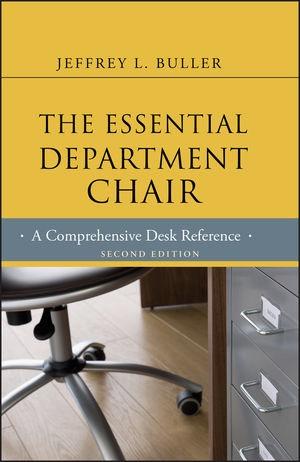
This second edition of the informative and influential The Essential Department Chair offers academic chairs and department heads the information they need to excel in their roles. This book is about the "how" of academic administration: for instance, how do you cultivate a potential donor for much-needed departmental resources? How do you persuade your department members to work together more harmoniously? How do you keep the people who report to you motivated and capable of seeing the big picture? Thoroughly revised, updated, and expanded, this classic resource covers a broad spectrum of timely topics and is now truly more than a guide—it's a much-needed desk reference that tells you "everything you need to know to be a department chair." The Essential Department Chair contains information on topics such as essentials of creating a strategic plan, developing and overseeing a budget, key elements of fundraising, preparing for the role of chair, meeting the challenges of mentoring to increase productivity, and creating a more collegial atmosphere. The book also explores the chair's role in the search process, shows how to conduct a successful interview and what to do when it's time to let someone go. And the author includes suggestions for the best practices to adopt when doing an evaluation or assessment. The Essential Department Chair, Second Edition, contains a wealth of new, realistic case studies to equip leaders in this pivotal position to excel in departmental and institutional life. (From the Publisher)
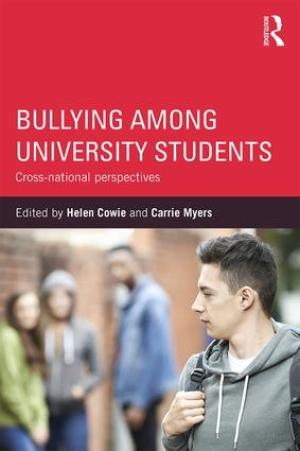
Helen Cowrie and Carrie-Anne Myers’ Bullying Among University Students studies bullying in universities worldwide, with contributors from educational psychology, criminology, counseling, media, and other disciplines. One insight of the volume is that we tend to address bullying as a relationship between the bully and the victim without addressing bullying’s social and institutional contexts. The introduction reminds us that university students occupy an ambiguous position, neither protected children nor employees. In the university, therefore, bullied students feel lost, reporting “that they do not know of any policies, systems, or avenues to help them” (3). The essays begin with the student experience, move to the nature of bullying, look at social context, suggest interventions and policies, and end with reflections, suggesting that universities might address bullying by coordinating communications between the students, staff, administrators, and student services and by using research on workplace bullying as a resource. The corporatization of higher education, valuing individualism and competition, may unconsciously generate a context for bullying, meaning that systems must be put in place to address bullying, including strong counseling. The writers align bullying with what they call “laddish” behavior – indeed, boys bully more frequently than girls – which Toni Pearce defines as a “‘pack’ mentality evident in activities, such as sport and heavy alcohol consumption and ‘banter,’ which were often sexist, misogynist and homophobic” (17-18). It includes sexualizing behavior toward women and intolerance of gay and transgender students and racial ethnic students, all vulnerable, which leads to harassment and violence. The essays examine multiple forms of bullying, including stalking and cyber-aggression, which occurs as “invisible” bullying (113). Drawing lines in these cases is a key, but difficult, act: when, for example, is online activity conversation, teasing, or bullying? One finding is that bullies tend to bully throughout their lives (36). Osman Tolga Aricak’s essay explores genetic and environmental causes of bullying and the impact on the bullies themselves. Aggression is an outward sign of complex issues like poor self- and impulse-control and narcissism. The bully and the victim can experience ongoing mental health disorders, including anxiety, depression, and isolation. “The Research Student Experience” chapter is informative for those of us supervising graduate students, unveiling the sometimes unconscious bullying in the power-laden supervisor-student relationship. Graduate students also occupy an ambiguous position, being students and teachers or workers, making them vulnerable. Graduate supervisors must be mindful of power, avoiding actions like giving excessive or unauthorized work to teaching assistants and using their research as the supervisor’s own. This collection offers immense insight into an understudied subject. One article on “Cross-Cultural Comparisons” reminds American universities that we have “some of the highest rates [of bullying] among the developed world” (135). Our cultural and economic diversity, insistence on free speech, and desensitizing media violence confuse notions regarding appropriate behaviors (135). Since there is not clear data on what works against bullying, a system-wide response is necessary.
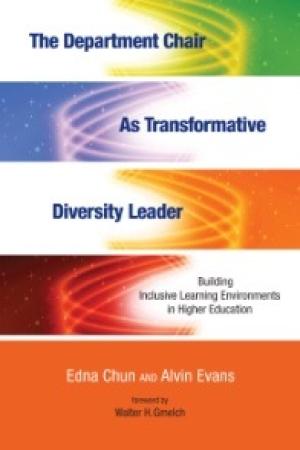
Edna Chun and Alvin Evans’ work on the department chair and diversity fills a gap in the literature on academic leadership. They argue that the academic chair is the pivot for diversity in higher education, particularly as increasing numbers of minoritized students enter the academy. Student diversity contrasts with the overwhelming white maleness of academic administrators, including 90 percent of chairs. Nevertheless, chairs are poised to enhance both the student experience of diversity and diverse faculty diversity development. The authors used an online survey and interviewed chairs across the nation to assess the current level of progress in diversity, to address barriers to diversity, to understand environmental factors that can promote or impede diversity, and to articulate strategies for developing diversity. They were particularly interested in talking with minoritized chairs and in the impact of diversity on student learning. By diversity, they mean race and ethnicity as well as gender and sexual orientation. Chun and Evans recognize that department chairs face many limitations in doing diversity work. Changing upper administrations, maintaining harmony in departments, and other issues take up much chair attention. The work begins with an overview of inequality in America, arguing that the role of higher education is to address this social landscape. They examine the challenges in higher education itself, from the impact of MOOCs to globalization and how department and institutional politics can block chairs’ diversity efforts. Serving students is key: Since minoritized students are at-risk for non-completion, campus climate, including diverse faculty and curriculum, can make a difference in those students’ lives. They also argue, in chapter 6, that interactional diversity is an essential dimension among high-impact college experiences for all student growth. Chairs, who occupy a double role as administrator and faculty, span boundaries and are potential bridge-builders. As both buffers and connections between faculty and administration, skilled chairs have the capacity to reflect on and transform these boundaries to mobilize the various stakeholders towards action. Chairs report to deans (analyzed in chapter 4), and trust in that that relationship is crucial for developing diversity, though the “revolving door” of administration in some institutions poses problems. The discussion of issues that minoritized chairs face and the voices of these persons is an important contribution of this book. These chairs are always proving their competence and may be taken less seriously than their white counterparts. A minority chair may be the only departmental voice for diversity. In terms of sexual orientation, some chairs are limited by institutions’ unwillingness to appoint or policies against appointment of LGBTQI chairs. Like minority faculty, minority chairs face lower student evaluations (see chapter 5), may be isolated and vulnerable, and are under great stress. Another key contribution is strategies, offered by chairs and the authors. Each chapter ends with strategies a chair may implement to address diversity. The final chapters offer suggestions for developing diversity plans, including helpful examples, and additional strategies for overcoming limitations. The description of higher education today, the voices of the chairs, and the multiple strategies offered create a rich study, insightful and practical, for aiding chairs to become leaders for a diverse academy in a global context.
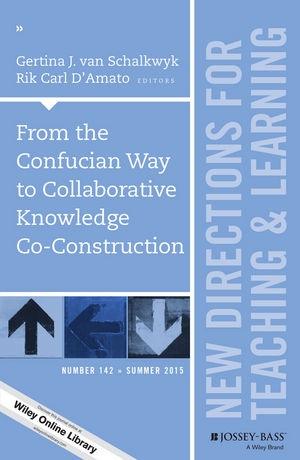
The five essays in this volume – on outcomes-based collaborative teaching, learning, and “authentic” assessment, and “connectivist” (86-87) uses of technology and media – are written for Western educators teaching in Asian contexts, but also for teachers in U. S. higher education. The volume is beautifully organized, with short summaries before each essay, as well as strong visuals – charts and illustrations – that summarize information and suggest application. The essays are individually valuable, but they do make a whole volume. The metaphor that the editors use for teaching and learning is choreography, “the rhythmic dance evolving between instructor and learner in the educational setting within higher education” (1). The teacher is a facilitator, moving students through “challenges and uncertainties,” with an emphasis on collaboration, in the Asian classroom. Tieyuan Guo’s introductory essay sets up the discussion, as it examines learning styles of students in and from Confucian Heritage Cultures (CHC). In CHC, students tend to be pragmatic learners (7), motivated by concrete outcomes. Confucian teaching emphasized ren, the cultivation of the human person, throughout a lifetime, towards virtue. The social, practical application of ren was in examinations (keju) used to identify and to promote government officials. This resulted in CHC students’ orientation to passing examinations that led to upward social mobility. Though the Confucian system officially ended in 1905, the understanding remains. CHC students, therefore, put more effort into study than their Western peers (9), and the student persona is different than the Western student. Confucian education values active silence in the classroom, indicating reflection and attentiveness; memorization, mastery, and understanding before application and critical analysis. Silence also involves respect for authority. These may combine to create only “surface learning” (14-15), leading CHC students to so worry about understanding that they do not move to critical thinking and about “losing face” that they do not ask questions. Non-Asian instructors should develop cultural understanding and sensitivity to make sure that CHC students learn. As van Schalkwyk illustrates, in a useful chart, an Asian student raised in a CHC culture accepts rules and hierarchy and prefers high levels of structure. A CHC student may need time in learning; therefore, group discussions and in-class assignments that a non-Asian student might enjoy may generate stress for the Asian student. In the third chapter, van Schalkwyk suggests ways to construct learning activities so as to be sensitive to CHC cultural realities. The fourth essay suggests linking activities to “authentic assessment,” in performance-based, sequential, and interlinked activities that move students towards higher-order cognitive processes (75). The final chapter examines the uses of technology to meet these goals. This important volume asks us to step back from now accepted language of, for example, outcomes assessment in American teaching and learning to understand their impact on Asian students, both in Asian societies and in the U. S. We should take up this challenge and add to it, working to understand how our institutional and classroom structures affect the learning of all students from diverse backgrounds.
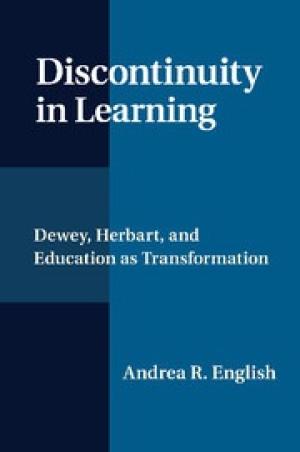
Andrea R. English’s Discontinuity in Learning re-links the work of Johann Friedrich Herbart with that of John Dewey. Dewey criticized Herbart’s work, causing, English argues, future critics to separate Dewey’s thought from its European predecessors (xx). English argues for continuity, that both thinkers want to identify and develop ways “for learners to recognize and respond to the other in judgments and actions” (104), through the experience of discontinuity. English’s excellent analysis of Herbart focuses on discontinuity, offering frameworks to analyze educational theories and practices that ignore discontinuity and reconnecting Anglo-American and Continental philosophies of education (xxiii-xxiv). I cannot do justice to this rich book here. I will focus on its main idea: education as discontinuity. English examines Herbart’s analysis of the educational possibilities in his contemporary’s (Kant’s) Categorical Imperative. To act so as not to treat others as things and as any other ethical person would act, one engages in moral choice. Herbart argues that educators can work with the experience of the discontinuous that emerges in encounter with the “other,” identifying where a learner already acts out of inner freedom (46) to move that learner to greater freedom, the capacity beyond “self-interested desires,” in recognition of and respect for the other (7). Discontinuity causes a pause (34) at the limits of one’s abilities and/or knowledge (xxii). This “in-between” (Dewey), “distance” (Herbart 16, 27), or “break” (English, 17) is a site of struggle (59) to transcend a limit. There, the learner can “identify and potentially change” her relation to the other (65). A teacher does not choose for the student, but designs an intellectual experience, to use Donald Finkel’s term, to scaffold the struggle (17), while, simultaneously, being open to improvisation on the design. Dewey agrees with Herbart: discontinuity is to “undergo or suffer the world” that upsets stable understandings (66), a starting-point for reflection (68). In learning, teacher and student struggle together in ongoing “critical self-relation.” For Dewey, the classroom is not just a site of moral struggle but of democratic action (89). Arriving at the social, as well as personal, “limits of thought and ability” (102), one learns, potentially, to choose for the good of all. Both the classroom and democratic society should support the deep learning that ensures freedom. For Dewey and Herbart, the goal of learning is right orientation to the other (105) through disorientation and reorientation, guided by the teacher who listens intently and generates dialogue, moving students to greater inner freedom and just action. The skilled teacher deploys “pedagogical tact” (50ff, 126ff.), discerning when to intervene in student learning and when to improvise (129) on the learning design. Neither teaching nor learning, therefore, can be determined as complete in outcomes and measured fully by evaluations. Nowadays we experience such “urgency” (55) about measures that we want to “predetermine” and “guarantee” learning (156). English argues, instead, for cherishing the discontinuous and valuing the improvisational space of the classroom in which teachers “acquaint the next generation” with their present world and prepare them for a “future yet to be discovered” (160).
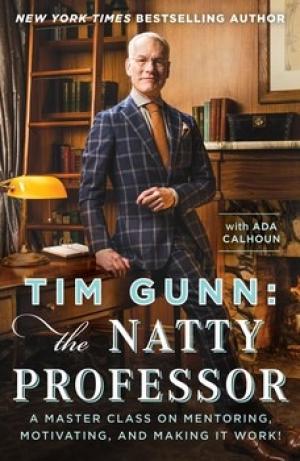
We are used to seeing Tim Gunn as the mentor on Project Runway, forgetting that Gunn is a teacher and chair at The New School’s Parsons School of Design where he also was a dean. The Natty Professor is part memoir, part reflection in which Gunn explains his T.E.A.C.H. philosophy, which involves: Truth-telling: “Injecting reality into situations” (xviii) . . . “because the world certainly will” (xvii). Empathy: Compassionate understanding of students’ experiences (75). Teachers evaluate the strengths and weaknesses of each student to help her become who she is as a thinker, not to shape a “mini-me.” Asking: Presenting insightful, tough questions, but also listening to help students ask and translate questions into practical application. For Gunn, good questions are the key to teaching, signaling creative curiosity. Questions also lead to cultivating and being in community: locating oneself where one is so as to open new paths in learning (178). Gunn urges us to keep curiosity supple by reading, traveling, and going, for example, to museums. Cheerleading: Supporting our students and helping them achieve their visions, even if we would do things otherwise (189); but also Hoping for the Best: Letting go because, in the end, it is up to them (223). Teachers cannot do the work for students. Gunn discusses difficult issues here, like discipline and grades. Gunn explains his principles through positive experiences, as well as through problems that teachers face, from making sure students read the syllabus to curriculum development. He also analyzes bad teaching: the bullies, the authority abusers, and the “drones,” the burnt-out and bored (156), saying that if you do not love it, leave. Interspersed through the book are testimonies from a variety of people about their most influential teachers. Three elements struck me strongly. First, perhaps because his is partly a practical field, Gunn offers powerful insights about mentoring, helping a student to reach her vision (13), which uses creatively, and sometimes transgressively, the skills and knowledge we teach. Second, Gunn cannot abide “preciousness.” Work will be shared with audiences: students become professionals in the world. Finally, Gunn argues that all and a variety of knowledge is important because, “Nothing . . . is ever wasted” (xv). Knowing generates capacities to adapt and to draw on knowledge so as to work effectively with challenges at hand. This is a good response to those who question the humanities’ demands for reading and writing with care within traditions and conventions. Diversity is also knowledge, serving us all as we work with a variety of persons, experience their knowledge and practices, and learn from them. I will watch Tim Gunn on Project Runway and Under the Gunn differently after reading his book. He is a wise master teacher in love with all classrooms. “Love your work!” above all (245). Gunn, as an administrator, teacher, and human being has much to teach us. I will be stealing shamelessly from his wisdom.
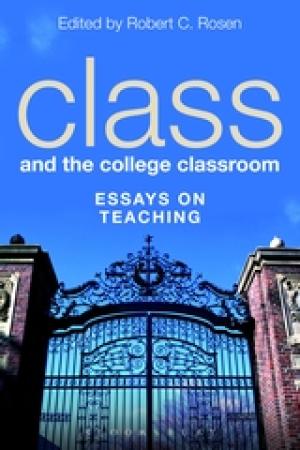
These essays, reprinted from Radical Teacher, analyze class in the classroom. Editor Robert Rosen recognizes that, in teaching about race, class, and gender, class often receives the least nuanced attention. With the 2008 economic downturn, class reemerged strongly: in the extreme inequalities in capitalist society; in the recognition that college is no longer the guaranteed “path to upward mobility” (1); and, in recognizing the functions of class in education’s many facets, from colleges to for-profits. Often, for poor (30-39) and immigrant, particularly undocumented (19-29), students, we are failing. This is true, as Susan Jhirad points out, even in community colleges, which have been the open door to college for many “non-traditional” students (40-48; 67-71). The book also gives voice to the working poor in the academy itself: alienated adjuncts (67-71; 78-86). We perform class as well as live it. Richard Ohmann writes about his students’ arguments against Jane Austen’s sense that one should strive to marry according to or up in class. His students, nevertheless, will enact her class vision. They come from the “professional-managerial class (PMC)” (12), and college, Ohmann suggests, lets them engage diversity, “for a while” (13), as they move back to the PMC. Class, he argues, is complex and powerful: an identity, “a script you act out daily, a bundle of habits and feelings and ways of relating lodged deep in your psyche and broadcast by your talk and conduct…[that] is [neither] easy to revise [nor to] conceal” (13). Erin Smith demonstrates this truth as she tells her current, less privileged, students about a white, male student from an elite university who refused to accept inclusive language, announcing “that when he was out in the real world, he would make all of those women and minorities working for him write the way he told them to” (113, emphases mine). While her less privileged students thought the young man was wrong, his example did not lead them to analyze class as a factor. Smith suggests, “a reliance on experience can effectively locate individuals in history, but it cannot – by itself – enable individuals to see history in themselves” (115-116): how they perform class. This book offers many teaching strategies, framed by the awareness that a classroom encounter with otherness often “‘substitutes’” for the real thing (147), “sanctioning,” as Ohmann writes, “all kinds of nonthreatening nonconformity” (147). The strategies unsettle class assumptions, such as Janet Casey’s teaching literature in terms of how it is marketed and Ohmann’s having his students write about their “imagined” best and worst jobs and whom they imagine works those jobs. This volume is valuable for its unflinching look at the current academy and for its warning that higher education, even as it works to be inclusive, can reproduce “class structures and relations” (146) appropriating “lower” class artifacts and making students confront class only within safe boundaries, changing nothing but the items on our syllabi.
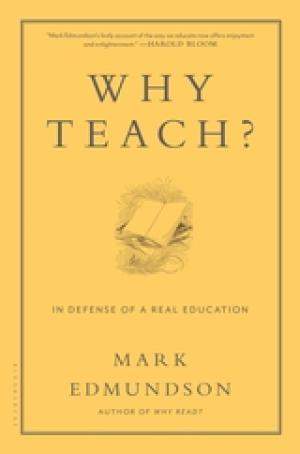
The “final vocabulary” is the network of meanings that our students bring into the classroom − that are true to them, and our job is to open that vocabulary to change. “All good teaching entails some kidnapping,” Edmundson writes; “there is a touch of malice involved . . . As well as some sorrow.” Mark Edmundson makes this remark in thinking about the teacher who introduced him to the intellectual life, Doug Meyers. Meyers sounds like most of us who love to teach: “strange, uncool,” “offbeat,” willing to be a little silly to make a point, and “counterintuitive” (181), as well as passionate about what we love, and, yes, a bit self-centered. Yet, Meyers’s gift as a teacher was to enter a high school classroom − in the same way that Wittgenstein entered elementary school classrooms − and, in his philosophy class, to probe, to adjust, to meet the students where they were, and to provoke. In Why Teach? Edmundson is well aware of what professors face in the “corporate city.” My university has never hosted monster trucks, as the University of Virginia did, but, like all colleges and universities, in its quest for the best students, highest awards, and so on, it is consumer driven. Sounding like Augustine of Hippo, Edmundson urges all of us − for this book is as much about being a student as being a teacher or being a student/teacher − to move within the corporate city to find the scholarly enclave, where one will be challenged. He asks us to stop thinking of teaching as “training and entertaining” (188). Edmundson is aware that teaching and learning is not the heart for most in the corporate city, but he urges us to make it so. Part of this is slowing students (and professors) down, turning students from their hyper fast-paced, technology-centered lives, powered by coffee, energy drinks, and endless choice − their desires always to be elsewhere (36) − towards something deeper. For Edmundson, whose father, a working-class man who had not had a college education and who urged Edmundson to follow his passions, education is to resist being the “intersections of many evaluative and potentially determining discourses” (59) and to seek to imagine and to interrogate whom we might become (63). This process − and Edmundson stresses process, with its necessary failures − is powered by finding our key interlocutors. For Edmundson, Freud (whose interlocutor is the Greek tragedians but, mostly, Shakespeare), Emerson, Plato, and others provide this role: “The best reason to read them is to see if they know you better than you know yourself. You may find your own suppressed and rejected thoughts following back to you with an ‘alienated majesty’” (61). As teachers, we should urge students − and ourselves − to face the challenges of those who do not agree with us and reason our ways through their power. We will find life thickened in this “soul making” (xiii) activity. Two things about this book are important for all teachers to know. First, our students are not dumb; they are overwhelmed by the desire for success: theirs, their parents’, and society’s emphasis on material wealth. Second, they are 9/11 babies, who live by carpe diem: avoiding closure, wanting endless choice (in terms of education: long drop-add periods, pass-fail options, and the ability to drop a class as late as possible with the “innocuous W” but also double and triple majors, with a minor or two thrown in), and always wanting to know everything and to be elsewhere. And, faced with this daunting configuration, they, ironically, avoid challenge. Edmundson begins his book with every professor’s worst day: the teaching evaluation day. He thinks about how these little exercises in “consumer expertise” (4), and good evaluations, unfortunately, often reflect how well we met the criteria of enjoyment (entertainment) and interest (consumption). This makes educational institutions like “northern outposts of Club Med” (26). To feed, therefore, the illusion of busyness and excellence, we may issue no challenges − in short, we may pander. To really try to educate this generation (and, I would add, to avoid the censure of their parents), to urge them to read, to which I will return, “to be influenced, to learn something new, to be thrown off . . . course and onto another, better way” (63) is risky. Edmundson demonstrates how he was thrown off and challenged by Meyers and by his experience of his own interlocutors. Homer, whom he uses to think about football and Lawrence Taylor, Plato, Emerson, William James, Malcolm X (whose book stressed Malcolm’s love for learning, oddly, was the book for a white, Irish Catholic working-class kid from Boston), William Blake, who had to deal with the corporate city in his own way because of his patron, and football, Ludacris, and Biggie Smalls all led Edmundson to and let him interrogate the life he lives. His endless curiosity reminds me of something Historian of Religions Charles H. Long once told me, that the intellectual is interested in everything. Edmundson urges us away from excellence, from always measuring and being in hierarchy, which our success-driven students have experienced in elementary and high school, to eloquence. If every subject, every major, is a language, and a student is adopting one, or more, of these languages as her own, she will “want to know how to speak it expertly” but also know its limitations: “how it fails to deal with those concerns for which it has no adequate words.” He continues, “You’ll be looking into the reach of every metaphor that every discipline offers, and you’ll be trying to see around their corners” (65). Edmundson shows us that teaching and learning and research and living are not separate. He makes a powerful case for a holistic and very human vision of the liberal arts: The quest at the center of a liberal arts education is not a luxury quest; it’s a necessity quest. If you do not undertake it, you risk leading a life of desperation − maybe quiet; maybe in time, very loud − and I am not exaggerating. For you risk trying to be someone other than who you are, which in the long run is killing. (59) What do the arguments of a professor of literature and theory have to do with those of us who teach religion? Edmundson cites Matthew Arnold’s recognition that underscores my area of Arts, Literature, and Religion: that if religion wanes, literature will be the site that holds meaning. But Edmundson knows that religion has not waned. He recognizes − comparing and contrasting the task of the University of Virginia, to develop the head, with the task of Jerry Falwell’s Liberty University, to develop the heart − that students do not divorce those. They are deeply concerned with the meaning of their lives; therefore, we cannot leave the heart (198) to Jerry Falwell. Students may put their experiences in a facile, non-interrogated way as “spirituality,” but, more often, they have deep commitments for which someone else has articulated the meaning. Edmundson recognizes that it is in religion that we most often encounter students’ “final vocabularies.” Edmundson reminds us that students bring these narratives into the classroom. They are “where our principles lie”; they are “the core” of being, and “the point beyond which mere analysis cannot go” (192). So, how do we go beyond them? We start with the head: reason and critical thinking. What religious studies and literature have in common, he suggests, is the love of books, of words. Both “attempt to teach one essential power, and they often do so with marked success”: reading (194). Through teaching students to read with care, we bring those “final vocabularies,” which really are only “for now” (193), into contact with other “final vocabularies,” not as a test or to create new hierarchies, but to generate critical reflection − to ignite what I call the moral imagination. Our aim in teaching students to read is not conversion. It is to move students to encounter with the “other”: to “encounter between the transcendental and the worldly” (198). Edmundson writes, “The objective is to help the students place their ultimate narratives in the foreground and render them susceptible to influence” (198). To get students to interrogate those held truths, Edmundson asks us to move beyond mere interpretation to meaning, asking the Platonic question: “Is it true?” (195). He is not asking us to deal in ultimate truths − the sense that we hold those is what encounter unsettles − but to teach so that our students interrogate the “live options” of a text − or for us, of another’s religious way of life (195). This sort of teaching does not replace religion, but teaches one to recognize that “a most pressing spiritual and intellectual task of the moment is to create a dialogue between religious and secular approaches to life” (197). Students may leave “with their religious convictions deepened,” but they are more “thoughtful believers than when they began” (197-198). We begin, therefore, in “secular dialogue” and move to what Edmondson calls “impersonation” or advocacy (201-202) for the text, in which we, the teachers, “offer an inspiring version of what is most vital in the author,” tempting our students into making the “past available to the uses of the present” (202). This lets us deal with the heart and spirit, not doing our students the “injustice” of leaving that to the Jerry Falwells of the world. I must say here that Edmundson does not dismiss what is new. He does not dismiss theory; he just asks readers to be wary of supplying “a standing set of terms to every text” (203). Theory, he suggests, reminds us of the power of books to persuade; that is why it is so careful of them. And he does not dismiss diversity and multiculturalism. He worries that we breaks boundaries too fast, “asking students to know others before they know themselves” (208) and supplying our students with just enough knowledge to be exploitative of the “other” in the global marketplace (208). Edmundson insists that the intellectual quest offers to our students the joy and passion we felt when we started out as students. This passion, he argues, is about the freedom of self-making in democracy, in articulating the self amid and in relation to the multiplicity of ways of being that we experience in the world. Using a metaphor familiar to those of us who teach religion, Edmundson speaks of maps. He argues that books can map or transform lives and that our students are in need of maps that both locate and challenge “their existing sense of the territory” (205), and that, with our carefully adversarial and joyful guidance, lead them into “self-aware self-revision” (207). I very much admire the courage and spirit of this book. Edmundson does not throw anything away: he, himself, is learning digital techniques for his classroom even as he insists on the “old-timey” practice of close reading. I hope that I have not made this book sound like a curmudgeonly defense of the “old days.” It is not. It is a beautifully written and often funny but careful reflection on what we gain by holding fast to and what we lose by abandoning the basics of a liberal arts education: reading, writing, fluency, and ongoing engagement in self- and world-reflection. There is an ongoing bass note that sounds through the book: Can you live it? That reminded me of a student in one of my religion and literature classes who told the class one day that he was trying to live out the ethos of each author as we read: “That D. H. Lawrence week,” he moaned, “was hell.” We all laughed, but learned something: that the trangressive, always-in-tension D. H. Lawrence, did not articulate as whole a vision of the good life as he thought he did. That student conquered what Edmundson calls “knowingness”: the sense that we know everything − or can find it on the web − and that we are in charge (181). He shows us a powerful way, one that continually reminds us of our useable past, to crack that tendency in ourselves and in our students. He speaks with the integrity of one willing to risk his own ultimate map all the time. This is a man, after all, who found one key interlocutor and intellectual companion in Malcolm X. Patricia O’Connell Killen always asks professors in workshops and colloquies two questions: “What is your passion?” and “When did you know you had asked a good question?” Killen’s second question points to what Edmundson is asking of us: not to dwell in certainty but to surrender to the joy of doubt and curiosity and to read, read, read. That path, perhaps, will lead us (back) to the answer for Killen’s second question, to our passions.
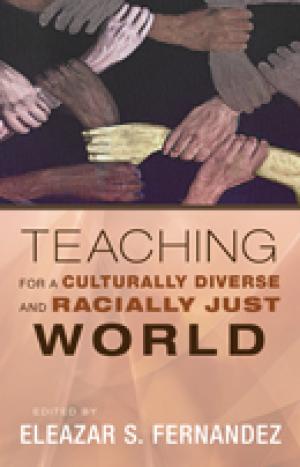
Eleazar S. Fernandez’s edited volume, Teaching for a Culturally Diverse and Racially Just World, brings together important voices in the study of religion and theology to explore issues surrounding racial-ethnic minority scholars. Fernandez writes that “‘marked’ identities” present challenges in all aspects of a scholarly career, from the classroom and research and publication to administration and institutional policy-making (2) and that even as racial-ethic minority scholars make great strides, the “racist system is cunning enough to do countermoves” (3). Willie James Jennings summarizes the crucial issue: “These teachers are measured against simulacrums, images of white male teachers, images of what women teachers ought to be, images of what minority teachers ought to be, and assumptions about which ideas and concepts should matter to women and minorities and which ideas and concepts are the proper domains of white men” (119), as David Maldonado, Jr. shows us the constraints and possibilities faced by racial-ethnic minorities across the institutional spectrum, including those in leadership positions. The purpose of this volume is not to complain, however, but to be constructive: it asks how institutions can re-form themselves, set “benchmarks” (4) to support racial-ethnic diversity, and, thereby, flourish.Two strategies characterize the volume. First, it deploys metaphors to help the reader to understand, even to experience, the positionality of the racial-ethnic scholar. For example, Jennings presents modern theological education as “the master’s house built exclusively for his sons” (109), while Loida I. Martell-Otero and Elizabeth Conde-Frazier use spatial metaphors to talk about “teacher space” and where our teaching takes place, respectively. With these metaphors, the volume asks what it means to work and to learn as “foreign bodies” in such places: what does it mean to be both at war and yet in love with our disciplines? The volume does not forget students; Peter Cha uses the metaphor of Martin Luther King, Jr.’s “Beloved Community” to think through the experience of racial-ethnic students in theological education. The volume asks us to think metaphorically in our assessment as well; it uses, for example, the vocational cycle as a way of thinking through justice work.A second strategy that characterizes the volume is the inclusion of the voices of allies. Paul O. Myhre and Nancy Ramsay offer valuable strategies and insights as two Euro-American colleagues who have accepted, as Ramsay puts it, “the pervasive influence of white supremacy and the recognition of the self-interested imperative for allies to leverage our privilege on behalf of institutional formation” (251). Using the metaphor of vision, Myhre asks us to expand our vision to see racism not as a singularity for racial-ethnic scholars but in its contexts, and to use the power of discernment to decide how to address the problem justly.This very important volume includes contributions from many stellar teachers. Though it focuses on theological education primarily, it is valuable for religious studies. Its range − from the location of the scholar, to students, to administration, to issues of assessment − is wide, but deftly handled. It is both theoretical and practical, making it a work one can mine for different kinds of insights. The volume asks for alliances that generate small but significant steps. As Fernandez puts it: “Small beginnings should not intimidate us. We must remember that we are not called to everything, but we are called to do something” (20).